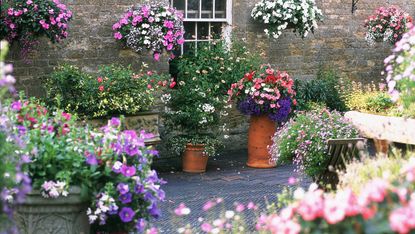Gardening in small spaces can feel like a daunting task, but with the right hacks, you can transform your urban garden into a vibrant oasis. Whether you have a tiny balcony, a narrow backyard, or just a few pots on your window sill, these easy gardening hacks will help you maximize your space and yield. Let’s dive into some creative and practical tips to make the most of your small gardening area.
Choosing the Right Containers

Container gardening is a fantastic solution for small spaces. It allows you to control the soil quality, drainage, and plant spacing. Here are some benefits and recommendations for choosing the right containers:
- Benefits: Containers offer flexibility in placement, allowing you to utilize sunlight and shade effectively. They also reduce soil-borne pests and diseases.
- Container Types: Opt for lightweight pots, hanging baskets, or self-watering containers. Consider using repurposed items like old buckets or wooden crates to add character to your garden while saving costs.
Vertical Gardening Techniques
Vertical gardening is a brilliant way to maximize your gardening area. By growing plants upwards instead of outwards, you can create a lush garden even in tight spaces. Here are some techniques:
- Wall Planters: Use wall-mounted planters or pockets made from fabric to grow herbs or small flowers. They not only save space but also create a stunning visual display.
- Trellises and Shelves: Install trellises against walls for climbing plants like peas or beans. Alternatively, utilize shelves to stack pots vertically, making efficient use of vertical space.
Utilizing Window Sills and Balconies
Your window sill and balcony can serve as prime real estate for your urban garden. Here are some ideas to make the most of these areas:
- Sunlight Exposure: Position your pots to maximize sunlight exposure. South-facing windows are ideal for plants that require full sun.
- Plant Suggestions: Herbs like basil, parsley, and mint thrive in small containers and can be conveniently accessed for cooking. For balconies, consider using railing planters to save floor space.
Companion Planting for Space Efficiency
Companion planting involves pairing plants that benefit each other, making it a smart strategy for small gardens. Here’s how to implement it:
- Benefits: This method not only maximizes space but also enhances growth, repels pests, and attracts beneficial insects.
- Best Combinations: Pair tomatoes with basil for improved flavor and pest control. Plant carrots alongside onions to deter carrot flies while utilizing space efficiently.
Creative Use of Space with Raised Beds

Raised beds can be a game-changer for small-space gardening. They elevate the garden, improve drainage, and extend the growing season. Here’s how to get started:
- Building Raised Beds: Use wood, bricks, or recycled materials to create raised beds that fit your available space. Keep them no wider than 4 feet for easy access.
- Arrangement Tips: Arrange raised beds in a staggered pattern to maximize sunlight and airflow. This design also adds visual interest to your garden.
Gardening Hacks for Maintenance and Care
Maintaining a small garden can be simplified with these handy hacks:
- Efficient Watering Techniques: Use drip irrigation systems or self-watering pots to minimize water waste and ensure your plants receive consistent moisture.
- Simple Pest Control: Implement natural pest deterrents like neem oil or insecticidal soap. Regularly inspect plants for signs of pests, and remove them by hand if necessary.
Maximizing Harvests with Succession Planting
Succession planting is an effective strategy to ensure continuous harvests in your small garden. Here’s how to do it:
- Understanding Succession Planting: This technique involves planting new crops in the same space once the previous ones have been harvested. It optimizes space and increases yield throughout the growing season.
- Implementation: Plan your planting schedule based on the growth rates of your crops. For instance, plant quick-growing crops like radishes or lettuce alongside slower-growing ones like tomatoes.
Incorporating Edible Plants in Small Spaces

Adding edible plants to your small garden not only beautifies your space but also provides fresh produce. Here are some suggestions:
- Best Edible Plants: Herbs like chives, cilantro, and thyme are perfect for small containers. For vegetables, consider growing dwarf varieties of peppers, tomatoes, and salad greens.
- Growing Tips: Utilize vertical space with hanging planters for strawberries or trailing herbs. This way, you can grow more without taking up additional ground space.
Conclusion
With these easy gardening hacks for small spaces, you can transform your urban garden into a thriving green space. Remember to choose the right containers, utilize vertical space, and incorporate companion planting to make the most of your limited area. Gardening can be both enjoyable and rewarding, even in the smallest of spaces. Start implementing these hacks today, and watch your urban garden flourish!

